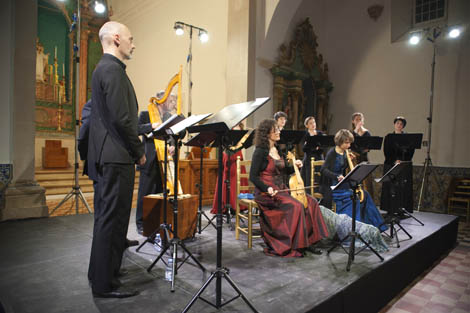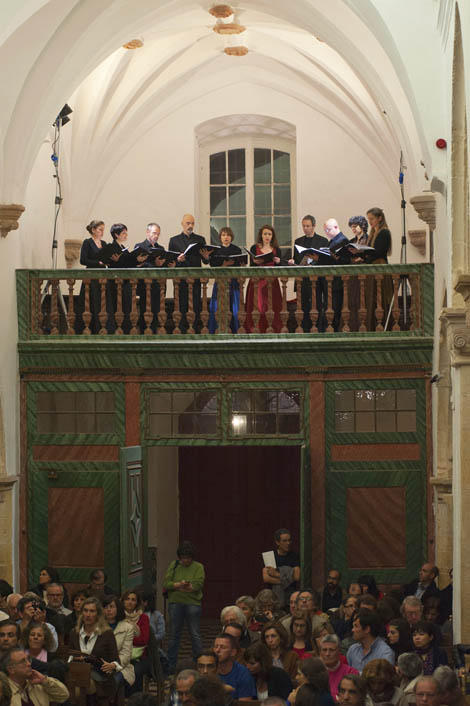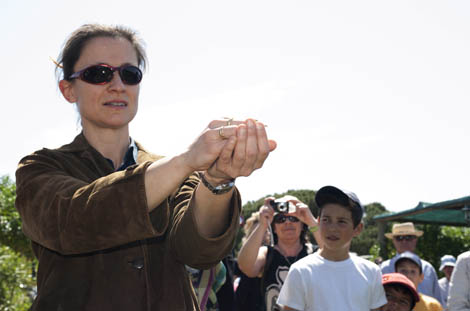 The parish church of Santiago do Cacém was packed to watch the first performance, in Portugal, of the Sancti Jacobi Mass, by Guillaume Dufay, with interpretation by the ensemble laReverdie, on Saturday, as part of the 9th Festival Terras Sem Sombra.
The parish church of Santiago do Cacém was packed to watch the first performance, in Portugal, of the Sancti Jacobi Mass, by Guillaume Dufay, with interpretation by the ensemble laReverdie, on Saturday, as part of the 9th Festival Terras Sem Sombra.
The virtuosity and uniqueness of the Italian group, considered the most important, in international terms, within its kind of early music, drew loud applause from an audience moved by the beauty of the music and the spirituality of a monument, exceptional from an acoustic point of view, which is a traditional crossing point for pilgrims from Compostela.
The Jacobean ways gain new vigor not only in the “classic” itineraries, but also in many others that were dormant, such as those in the south of Portugal.
According to José António Falcão, director of the Heritage Department of the Diocese of Beja, at the opening of the concert, “the Camino de Santiago has been taking on a major role throughout the Alentejo, and currently they cross the region every year. , thousands of pilgrims, with Santiago do Cacém – and its Gothic church dedicated to the apostle – occupying a prominent place in this process. It is a fundamental axis of the pilgrimage to Compostela”.
Thus, the choice of such a symbolic place for the presentation of a landmark of the Jacobean cultural heritage is understandable.
 In chronological terms, the Sancti Jacobi Mass it is the second of Dufay's masses and was composed between 1426 and 1428. The only source that contains the complete work is Codex Q15 of the Bibliographical Museum, in Bologna, of which Claudia Caffagni – conductor of LaReverdie – carried out a new transcription.
In chronological terms, the Sancti Jacobi Mass it is the second of Dufay's masses and was composed between 1426 and 1428. The only source that contains the complete work is Codex Q15 of the Bibliographical Museum, in Bologna, of which Claudia Caffagni – conductor of LaReverdie – carried out a new transcription.
This rediscovery does justice to the talent of Dufay, considered the main composer of the first half of the XNUMXth century.
For the Festival Terras Sem Sombra, as explained by the artistic director Paolo Pinamonti, the concert in Santiago do Cacém represents another important step towards internationalization, with the particularity of confirming a close association with the Caminho Compostelano, the first European cultural route, which the Diocese of Beja has come to appreciate. “The initiative is a decisive step in the path we are following, closely linked to the heritage of pilgrimages”, he stressed.
Release birds in Lagoa de Santo André
In the morning of the next day, musicians, spectators, conservation specialists and children from Santo André's schools (accompanied by the families) carried out an activity to enhance the biodiversity of Terras Sem Sombra, targeting the Santo André lagoon, a privileged stop. for many species of birds on the migratory route between Europe and Africa.
In addition to an observation route, we worked hard on the restoration of the Natural Reserve's visitation structures, degraded by vandalism, and on the ringing and monitoring of birds at risk.
This activity, organized in partnership with the Institute for the Conservation of Nature and Forests, took place at the National Ornithological Station of Santo André.
At the hands of volunteers, several birds were released to freedom. His godparents were Elisabetta de Mircovich, on behalf of laReverdie, conductor Giovani Andreoli, from the São Carlos National Theater, and two children from local schools, symbolizing the future that these actions provide.
 Festival continues on May 4th in Grândola
Festival continues on May 4th in Grândola
The 9th edition of the Festival Terras Sem Sombra continues until the 13th of July, with passages marked by Beja, Vila de Frades, Castro Verde, Carvalhal, Comporta, and Sines.
Until then, the concerts will continue on the 4th of May, in Grândola, with a show dedicated to musical poetry and poetic music, by the group La Poème Harmonique, with Marc Mauillon, Vivabiancaluna Biffi, Michaël Grébil and Pierre Hamon.
The biodiversity activity, the following morning, will focus on the sustainable management of the cork oak forest, the dominant landscape in this region.


















Comments